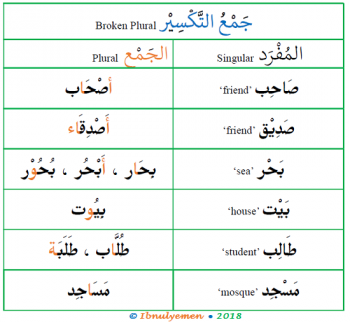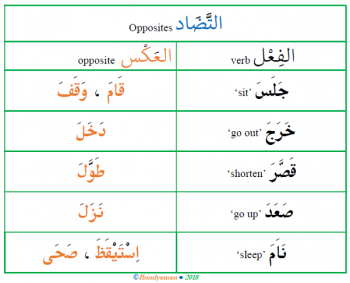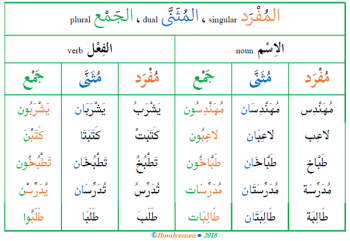Archive by Author
Assimilation in Arabic Posted by Ibnulyemen اِبْنُ اليَمَن on Jul 12, 2018

In natural speech, it is always difficult to utter a sound twice in a row, as in عَلْلَم which becomes عَلَّم. It is also relatively difficult to produce two sounds from the same area of articulation consecutively, as in مِنْ رَأْسِكَ which is pronounced as مِرَّأْسِكَ. Therefore, we recourse to assimilation. In Arabic, assimilation الإِدْغَام…
Broken Plural in Arabic Posted by Ibnulyemen اِبْنُ اليَمَن on Jul 5, 2018

In a previous post, you learned that Arabic plural nouns are three forms: sound masculine plural جَمْعُ المُذَكَّرِ السَّالِم, sound feminine plural جَمْعُ المُؤَنَّثِ السَّالِم, and broken plural جَمْعُ التَّكْسِيْر. The first two are regular because their formation entail adding a suffix (i.e. ون and ات, respectively) to the end of the singular without a…
Deriving Nouns from Verbs in Arabic (1) Posted by Ibnulyemen اِبْنُ اليَمَن on Jul 3, 2018

A distinguishing feature of Arabic language is that it is a derivational language. Multiple words are derived from a single root word based specific morphological rules. Using the morphological measure, affixes (suffixes, prefixes, and infixes) are appended to the root word forming news words. For example, form the root كَتَبَ ‘write’, we derive كَاتِب ‘writer’…
Relative Clauses in Arabic Posted by Ibnulyemen اِبْنُ اليَمَن on Jun 23, 2018

A relative clause is a clause (i.e. part of a sentence that does make a complete meaning) that begins with a relative pronoun. It is also called adjective clause. It functions as an adjective because it provides more information (i.e. describes) the noun or pronoun that come before it. In Arabic, it is called جُمْلَة…
The Arabic Morphological Measure Posted by Ibnulyemen اِبْنُ اليَمَن on Jun 14, 2018

The Arabic morphological measure المِيْزَان الصَّرْفِي is a measure that is proposed by Arabic grammarians to know and weigh the structure of words. It helps in understanding the internal structure of words, namely knowing whether the constituent letters of a word are essential or additional, and in deriving new words from the same root. The…
20 Common Opposite Verbs in Arabic Posted by Ibnulyemen اِبْنُ اليَمَن on May 31, 2018

A good strategy to augment our vocabulary when learning a new language is through opposites. Conjugating them by deriving different forms from the root further enhance our acquisition, and lead to more spontaneous usage. This post provides a list of 20 common opposite verbs with example sentence. الفِعْل verb مَاضٍ ، مُضَارِع ، مُسْتَقْبَل…
Forms of Nominal and Verbal Plurals in Arabic Posted by Ibnulyemen اِبْنُ اليَمَن on May 29, 2018

As explained in an earlier post, nouns الأَسْمَاء and verbs الأَفْعَال have three forms: singular مُفْرَد, dual مُثَنَّى, or plural جَمْع. Unlike the formation of dual noun forms, plural noun forms are a bit more complex because they constitute three types: sound masculine plural جَمْع مُذَكَّر سَالِم, sound feminine plural جَمْع مُؤَنَّث سَالِم, and broken…


